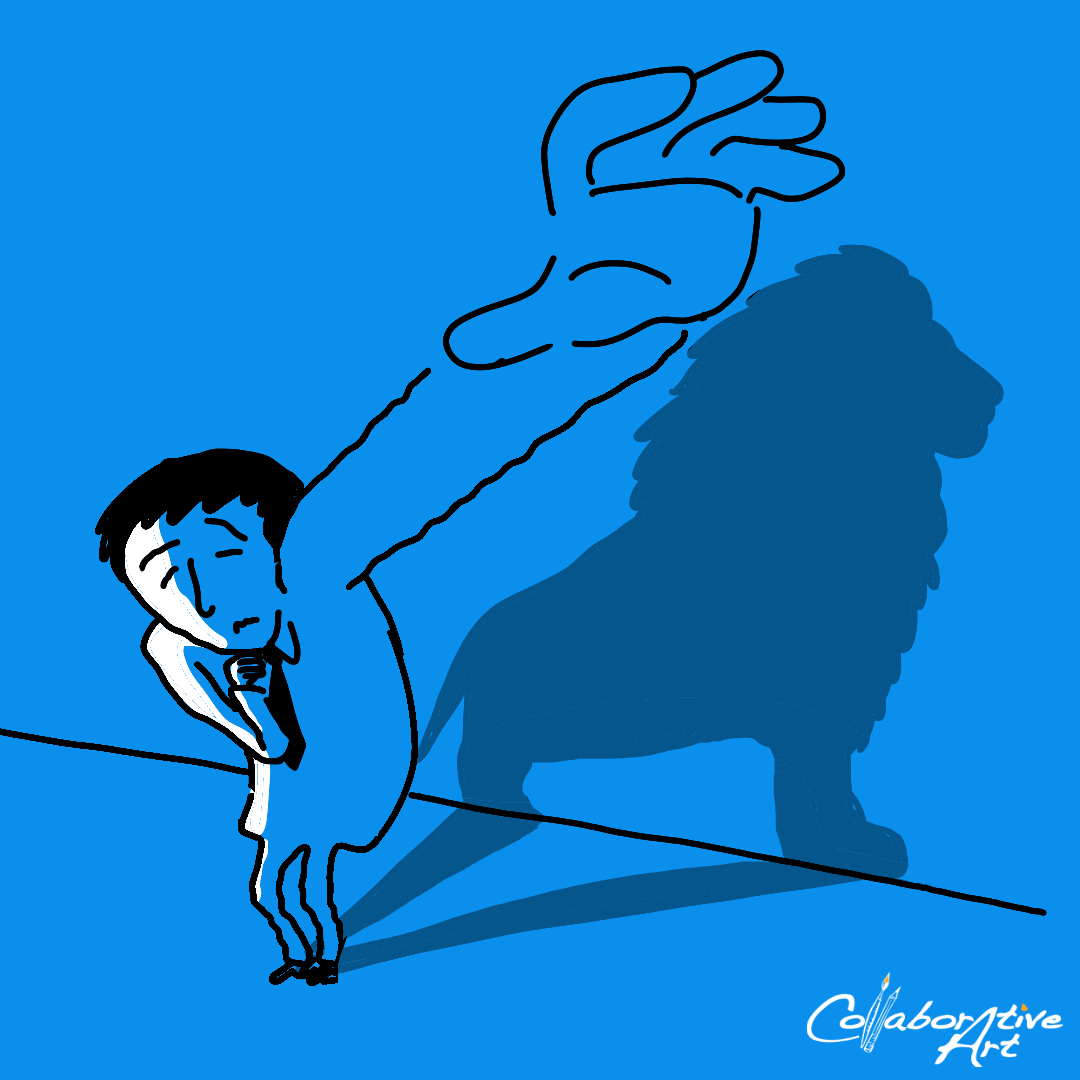Creative courage is a crucial skill in any leader’s and professional’s toolkit. How can you foster it for your career and personal success?
Has anything like this ever happened in your team?
You meet to discuss a new strategy for a client project or a marketing campaign, for example.
The ideas start flowing, and there’s a palpable sense of excitement and energy. However, as the discussion progresses, an air of disappointment starts to permeate the meeting room.
Many team members are hesitant to voice their more daring ideas, and most ideas shared are quite conventional.
Why is this happening? The team members are experienced, creative, smart and motivated. Why are they only coming up with standard, off-the-shelf ideas?
There’s a simple explanation: a lack of creative courage.
What is Creative Courage?
In our previous article, we introduced Creativity and Company, their friends, and bad influences. We looked at their impact on how much of our inherent Creativity is unleashed to change the world.
One of Creativity’s friends is particularly interesting for professionals and teams who want to be bold enough to explore new ideas, challenge conventional thinking and push the boundaries to create something new and innovative.
It is Courage.

Creative Courage is the willingness and determination to take risks to pursue creative endeavours. A creative act doesn’t only mean writing books or producing sculptures; it means creating anything that doesn’t yet exist, from marketing campaigns to visionary business transformations.
Creative Courage empowers individuals to express themselves authentically and bring about meaningful innovation despite the potential criticism.
Companies that nurture Creative Courage find it easier to stay relevant, adapt to rapid changes and create cutting-edge innovation. Creative Courage also translates to a strong employee experience, long and committed work relationships and decreased employee turnover.
Unfortunately, we struggle to nurture Creative Courage because of human nature and societal conditioning.
Why are Leaders Bad at Creative Courage?
If you recognise yourself in the courage-stifling description above, don’t feel bad. We are naturally risk-averse, and our entire school and societal system is built on repressing Creative Courage.
As Sir Ken Robinson has stated - and many of us witnessed and experienced in our lives - at schools, mistakes are often perceived as the worst thing you can make.
When children graduate and enter the workforce, they unintentionally take that culture of avoiding mistakes with them.
Turning this combination of inherent and learned risk aversion into Creative Courage requires intentional leadership. We need to become more conscious of the instinctive “fight, flight or freeze” reaction and choose to reimagine our environment, break out of patterns, shift our perspectives and discover new possibilities and solutions, even under pressure.
Fortunately, Creative Courage is a learnable skill! Through my work in creative roles and with teams and leaders at every level, I’ve identified four key approaches that allow us to nurture the inherent Creative Courage within ourselves and our teams.
Nurture Creative Courage Through Failure
To nurture Creative Courage in the workplace, we need to rewire our fear of making mistakes by seeing them as friends, not foes. Leaders must cultivate an environment welcoming collaborative relationships, experiments, and an open feedback process.
Here’s a personal example: when I started Collaborative Art® Team Building, the current business model wasn’t my first iteration. It only came to life through varying degrees of trial and error. I could have seen them as failures and just given up, but I didn’t - I saw them as learnings.
Still, all these experiences, including other professional experiences, were necessary to develop the successful Collaborative Art® method that delights my clients today. These experiments allowed me to develop my confidence as a facilitator and strengthened my trust in the process and my budding Creativity.
As Rick Rubin has said, “Failure is the information you need to get to where you are going”.
And that is the simplest mindset shift practice that leaders and organisations can exercise. Bake failure into your processes and approach them as nothing more than they are: information!
In the beginning, receiving information about what works and what doesn’t feels uncomfortable. However, the more you practise, the more comfortable you become with the discomfort and can start appreciating this information as a golden gift.
In practice, this can mean a team combing through so-called failures, e.g. steps to success, to learn from them or a leader vulnerably sharing their career twists and turns to normalise a windy road to success. Some companies invite keynote speakers like me to share stories to inspire their teams to be more resilient and think outside the box.
Reframe Constraints as Opportunities
Another practice to challenge conventional thinking is to learn by looking at constraints from a different perspective than the one we’re used to.
One exercise I like to use in my workshops and speeches is asking the participants to “Halve the number 13”.
Does your mind go straight to 6.5?
And what would you think if I told you there are at least five other ways to complete the task? If you're itching to know the answers, type “What else is half of 13?” in the comments!
Courageous Leaders Challenge Assumptions
Similarly, Creative Courage requires rethinking assumptions and stepping over the way things have always been done.
How many ideas have been trumped in a staff meeting or creative brainstorming session because “That is not how we do things”?
For example, when my team and I run Collaborative Art® workshops with teams, we often hear people complaining they can’t paint or draw. They find it seemingly impossible to create a masterpiece within a couple of hours using a famous artist’s style.
But that is a limiting belief, a negative assumption! Challenging that assumption in our shared vision workshops allows the participants to turn their doubt into pride.
Moreover, seeing your team’s masterpiece in the office regularly is a powerful visual reminder that anything is possible with your colleagues when you choose to follow your Creative Courage to step out of your comfort zone.
Challenging yourself and your team to identify and challenge invisible assumptions in an unrelated field, such as a team-building exercise, spills over and unleashes creative problem-solving in other areas.
See below for the shared masterpiece the Kinetic Consulting team created in only 2.5 hours, following Joan Miró’s unique style!
Foster the Curiosity to See Things Differently
When teams, leaders and organisations first find the Courage to think of failure as part of the process, to reframe constraints creatively and challenge unspoken assumptions, they open doors to innovation. To take these insights into everyday life, teams also need to foster Curiosity inside and outside the workplace to find the Courage to see things differently.
This is easier said than done. To make the concept more approachable, I’ll share one more example from my career.
Medicines for Malaria Venture, a non-profit organisation that saves lives by containing malaria, contacted me to collaborate on creating something special for their anniversary celebrations.
Suggesting traditional graphics and slide decks would have been easy, but I took my Creative Courage by the horns and proposed something unexpected. After all, they wanted a “creative fest”.
The result included, among other things, a giant clasping hand sculpture symbolising partnerships and nurturing communities that became Live Interactive Art with collages and graffiti during the event. Plus, a series of mosquito sculptures contained in Plexi boxes were creative centrepieces and conversation starters. Both are still proudly displayed in their offices in Geneva.
Not only that, but every year, they commission more mosquitoes as gifts for VIPs, partners, and retirees. This is just one example of how Curiosity and Courage to do things differently led to unexpected and recurring business opportunities.
How do you Foster Creativity within your Team?
With these examples and exercises, I wish to demystify the concept of Creative Courage and highlight that changing things isn’t necessarily easy. To foster Creative Courage in the workplace, we need to unravel limiting beliefs about Creativity and human beings' risk-averse nature.
Solving that problem is one reason I created Collaborative Art® in the first place: my mission is to support organisations and leaders who want to embrace Creativity and use it to drive their businesses forward.
There is Creativity and Courage in each one of us. By existing, we inherently become creators in the deepest sense, shaping our reality experiences and moulding the world we perceive.
“Creativity is a fundamental aspect of being human. It’s our birthright. And it’s for all of us. Creativity doesn’t exclusively relate to making art. We all engage in creative acts daily”, Rick Rubin writes in The Creative Act: A Way of Being.
One Speech Can Ignite Creative Courage
Advocating for this approach is also why I love organising leadership training and giving keynote speeches. Even a short workshop or speech can ignite the spark of Creative Courage within teams.
Feedback, like the below from Thomas Sengmany at Vacheron Constantin, reminds me of the importance of this work:
“Steph helped us kick-start our off-site with a thought-provoking speech on Creative Courage. We wanted the teams to gain tips on becoming more resilient and thinking out of the box. Steph did so perfectly by sharing her experience and life stories with us. The intervention was very impactful, and everyone left that day with a list of actions they would do to be more creative and courageous.”
You can read here how our clients have gained more Creative Courage through our collaborations.
To spark Creativity within your team and organisation, get in touch, and we can create an event or training that supports shifting mindsets and getting comfortable with the uncomfortable to keep your organisational culture ahead of the game.
About the Author

Steph Fonteyn is an internationally exhibited artist, corporate facilitator and the founder of Collaborative Art® team building. She ties together the fine threads of creativity, courage and leadership to provide her clients with transformative team-building and workshop experiences. Her mission is to empower professionals worldwide to tap into their inherent creativity to be better leaders and bring about change.
Steph founded Collaborative Art® in 2011 to unite teams around a shared vision through art, and she has developed innovative techniques to unlock both the creative and collaborative potential in teams. With her artistic talent, public speaking skills, HR experience, and team-building expertise, Steph has become a respected figure in creativity, communication, and leadership.
As an award-winning public speaker, she has shared her expertise on creativity and courage at various events, including TEDx in 2015.
Steph splits her time between creative artwork and supporting companies through creative, collaborative team-building activities. She lives in Switzerland, near Geneva.